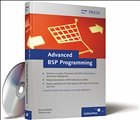Nicht lieferbar

Advanced BSP Programming
Versandkostenfrei!
Nicht lieferbar
Based on the most prolific weblog in the SAP Developer Network, this book deals with the most relevant problems in BSP development. Regardless if insider know-how on the basics and on programming or valuable hints on boosting performance and on troubleshooting: Every chapter deals with those questions that you have to struggle with in your everyday work.
The book also contains exclusive chapters, for example on TableView renderers, F4 helps, and BSP integration in the SAP GUI.
The book also contains exclusive chapters, for example on TableView renderers, F4 helps, and BSP integration in the SAP GUI.



